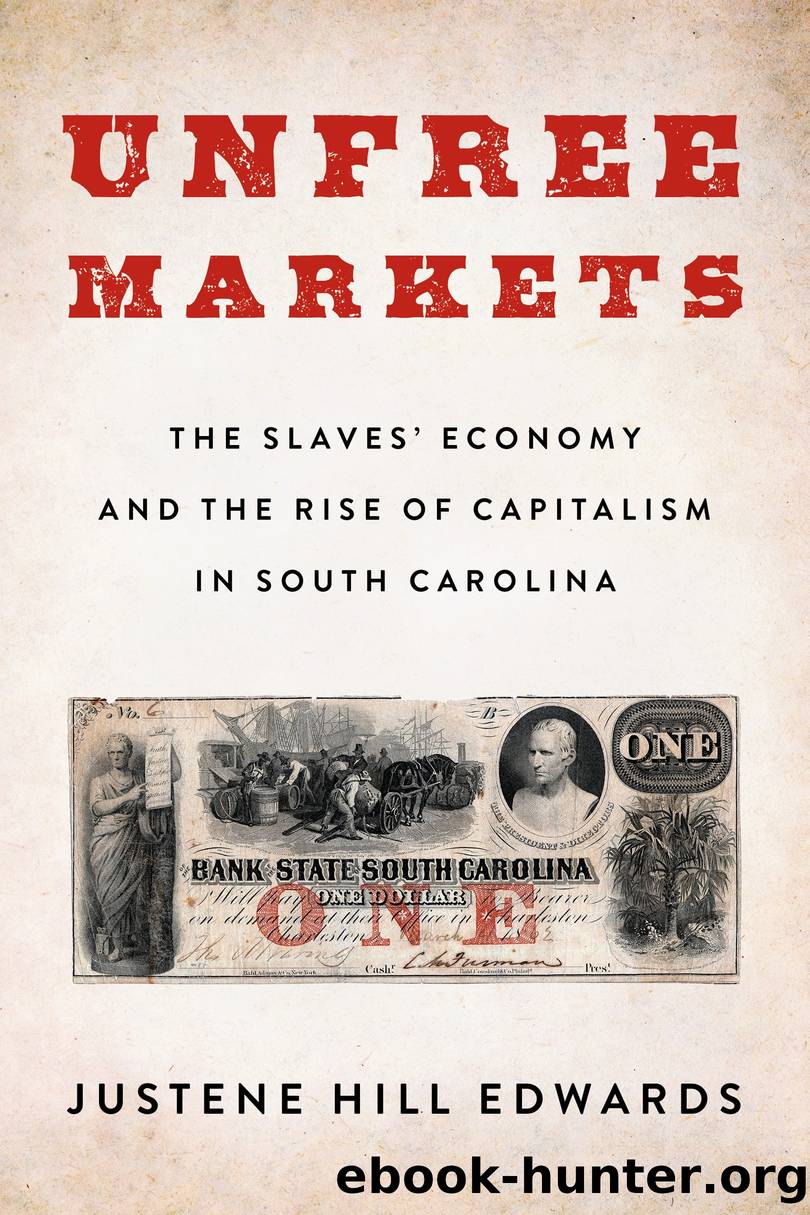Unfree Markets by Justene Hill Edwards

Author:Justene Hill Edwards
Language: eng
Format: epub
Publisher: Columbia University Press
* * *
The eagerness with which enslavers and merchants scrambled to profit from enslaved peoplesâ entrepreneurship only increased after the Panic of 1837. General unease increased among enslavers amidst the backdrop of economic uncertainty, in particular the cotton marketâs unpredictability in the late 1830s. Economic forces compelled South Carolina planters to consider different ways in which to maintain their investments in monoculture as the international demand for Southern cotton waned. This volatilityâor perhaps insecurityâaffected cotton prices. Between 1837 and 1849, the price of short-staple cotton fluctuated between $0.05 and $0.10 per pound, the lowest prices since the beginning of the nineteenth century. Concurrently, global demand for Southern cotton weakened in the midst of financial turmoil. The cotton marketâs instability challenged South Carolina plantersâ enthusiasm not about cotton as an industry, but on cotton monoculture.58
Enslaved people endured more suffering when enslavers became dedicated to the cultivation of and profit from one product. When enslavers stopped providing food and raiment to them, bondspeople were coerced to spend their already meager free time cultivating not only food for themselves, but also other essential items for the entire plantation community. Though enslaved people were being compensated by enslavers and merchants for their independent cultivation, these same enslavers and merchants increasingly took advantage of these forced economic relationships to bilk slaves out of the fair market value of their goods.
Moreover, enslaved people absorbed slaveholdersâ increasing dependence on them to both harvest record amounts of cotton and dedicate more of their free time toward income-generating work. Enslaved woman Margaret Bryant witnessed her mother, a skilled weaver, work day and night to âmake up that cloth to please the obersheer [sic].â She also invested her free time weaving extra yarn to sell to other enslaved people and poor whites.59 She revealed that poor white men would âcome there and buy cloth from Ma. Buy three or four yard.â60 In her cloth trade, when Bryantâs mother sold cloth to other enslaved people, she often did not receive money as compensation. Instead Bryantâs mother would receive hogs or other commodities as payment for her cloth.
In theory, enslaved peoplesâ extra work as producers of goods for the market allowed enslavers to maintain a singular focus on monoculture. Ultimately, enslaversâ dedication to monocultureâfirst rice, then cottonâthreatened plantation self-sufficiency. For example, a planter who neglected subsistence farming and forced enslaved people to focus singularly on cotton cultivation risked dependence on external growers to provide food for not only themselves, but their slaves and livestock as well. When slaveholders relied on and purchased necessary foodstuff from upper South states such as Virginia for the nutritional needs of their slaves, they risked undermining the financial stability of their plantation enterprises. This concern, however, did not deter enslavers from investing in cotton monoculture. The profits to be made from cotton were so seductive that slave owners, before the 1840s, ignored the clear benefits of subsistence farming.61
For enslaved people, however, neither the financial panic nor its causes thwarted their participation in trade with their enslavers or with local merchants.
Download
This site does not store any files on its server. We only index and link to content provided by other sites. Please contact the content providers to delete copyright contents if any and email us, we'll remove relevant links or contents immediately.
Rich Dad Poor Dad by Robert T. Kiyosaki(6197)
Pioneering Portfolio Management by David F. Swensen(6092)
How To Win Friends and Influence People by Dale Carnegie(4342)
The Money Culture by Michael Lewis(3862)
The Dhandho Investor by Mohnish Pabrai(3575)
The Wisdom of Finance by Mihir Desai(3539)
Liar's Poker by Michael Lewis(3234)
The Intelligent Investor by Benjamin Graham Jason Zweig(2940)
The ONE Thing by Gary Keller(2925)
Mastering Bitcoin: Programming the Open Blockchain by Andreas M. Antonopoulos(2902)
Fooled by Randomness: The Hidden Role of Chance in Life and in the Markets by Nassim Nicholas Taleb(2872)
Rich Dad Poor Dad: What The Rich Teach Their Kids About Money - That The Poor And Middle Class Do Not! by Robert T. Kiyosaki(2842)
Investing For Dummies by Eric Tyson(2805)
How to Win Friends and Influence People by Dale Carnegie(2803)
How to Day Trade for a Living: Tools, Tactics, Money Management, Discipline and Trading Psychology by Andrew Aziz(2792)
Market Wizards by Jack D. Schwager(2550)
Zero Hour by Harry S. Dent Jr. & Andrew Pancholi(2542)
How to Pay Zero Taxes, 2018 by Jeff A. Schnepper(2512)
Rich Dad's Guide to Investing by Robert T. Kiyosaki(2418)
